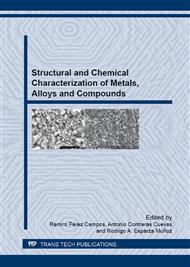[1]
O. Lupan, T. Pauporté, I.M. Tiginyanu, V.V. Ursaki, V. Şontea, L.K. Ono, B. Roldan Cuenya, L. Chow, Comparative study of hydrothermal treatment and thermal annealing effects on the properties of electrodeposited micro-columnar ZnO thin films, Thin Solid Films 519 (2011).
DOI: 10.1016/j.tsf.2011.05.072
Google Scholar
[2]
Ü. Özgür, Ya. I. Alivov, C. Liu, A. Teke, M. A. Reshchikov, S. Doğan, V. Avrutin, S. -J. Cho, and H. Morkoç, A comprehensive review of ZnO materials and devices, Journal of Applied Physics 98 (2005) 041301.
DOI: 10.1063/1.1992666
Google Scholar
[3]
C. Chen, B. Yu, P. Liu, J. F. Liu and L. Wan, Investigation of nano-sized ZnO particles fabricated by various synthesis routes, Journal of Ceramic Processing Research 12 (2011) 420–425.
Google Scholar
[4]
V. A. Nikitenko, K. E. Tarkpea, I. V. Pykanov, and S. G. Stoyukhin, EPR and thermoluminescence in ZnO single crystals with anionic vacancies, Journal of Applied Spectroscopy 68 (2001) 502-507.
DOI: 10.1023/a:1011975028398
Google Scholar
[5]
Walid A. Hadi, Michael S. Shur, Stephen K. O'Leary, Transient electron transport in the III-V compound semiconductors gallium arsenide and gallium nitride, J. Mater Sci: Mater Electron 23 (2012) 1-7.
DOI: 10.1007/s10854-012-0818-2
Google Scholar
[6]
D. Millers, L. Grigorjeva, W. Łojkowski, T. Strachowski, Luminescence of ZnO nanopowders, Radiation Measurement 38 (2004) 589-591.
DOI: 10.1016/j.radmeas.2004.05.001
Google Scholar
[7]
R. Chen, S.W.S. McKeever: Theory of Thermoluminescence and Related Phenomena, (World Scientific, Singapore, 1997).
Google Scholar
[8]
V. A. Vorob'ev, Investigation of thermally stimulated luminescence of zinc oxide with low-voltage excitation, J. Opt. Technol. 72 (2005) 690–692.
DOI: 10.1364/jot.72.000690
Google Scholar
[9]
Metin Bedir, Mustafa Öztas, A. Necmeddin Yazici, E. Vural Kafadar, Characterization of undoped and cu-doped ZnO thin films deposited on glass substrates by spray pyrolysis, Chinese Physics Letters 23 (2006) 939-942.
DOI: 10.1088/0256-307x/23/4/049
Google Scholar
[10]
D. Diwan, S. Bhushan, S. P. Kathuria, Thermoluminescence of ZnO: Cu, La under UV and γ-ray irradiation, Crystal Research and Technology 19 (1984) 1265-1269.
DOI: 10.1002/crat.2170190922
Google Scholar
[11]
D. De Muer and W. M. Van der Vorst, Thermoluminescence of ZnO powder, Physica 39 (1968) 123-132.
DOI: 10.1016/0031-8914(68)90053-0
Google Scholar
[12]
D. Zwingel, Trapping and recombination processes in the thermoluminescence of Li-doped ZnO single crystals, Journal of Luminescence 5 (1972) 385-405.
DOI: 10.1016/0022-2313(72)90001-4
Google Scholar
[13]
Mustafa Öztas, Characteristics of annealed ZnO: Cu nanoparticles prepared by spray pyrolysis, J. Mater Sci: Mater Electron 17 (2006) 937-941.
DOI: 10.1007/s10854-006-0047-7
Google Scholar
[14]
A. Necmeddin Yazici, Mustafa Öztas, Metin Bedir, The thermoluminescence properties of copper doped ZnS nanophosphor, Optical Materials 29 (2007) 1091–1096.
DOI: 10.1016/j.optmat.2006.04.010
Google Scholar
[15]
Po-Tsung Hsieh, Ying-Chung Chen, Kuo-Sheng Kao, Chih-Ming Wang, Structural and luminescent characteristics of non-stoichiometric ZnO films by various sputtering and annealing temperatures, Physica B 403 (2008) 178–183.
DOI: 10.1016/j.physb.2007.08.172
Google Scholar
[16]
C. Cruz-Vázquez, R. Bernal, S.E. Burruel-Ibarra, H. Grijalva-Monteverde, M. Barboza-Flores, Thermoluminescence properties of new ZnO nanophosphors exposed to beta irradiation, Optical Materials 27 (2005) 1235–1239.
DOI: 10.1016/j.optmat.2004.11.016
Google Scholar
[17]
C. Cruz-Vázquez, S.E. Burruel-Ibarra, H. Grijalva-Monteverde, V. Chernov, R. Bernal, Thermally and optically stimulated luminescence of new ZnO nanophosphors exposed to beta particle irradiation, Radiation Effects and Defects in Solids 162 (2007).
DOI: 10.1080/10420150701482089
Google Scholar
[18]
C. Cruz-Vázquez, F. Rocha-Alonzo, S.E. Burruel-Ibarra, A new chemical bath deposition method for fabricating ZnS, Zn(OH)2, and ZnO thin films, and the optical and structural characterization of these materials, Appl. Phys. A: Mater. Sci. Process 79 (2004).
DOI: 10.1007/s00339-003-2097-5
Google Scholar
[19]
Mayagoitia Barragán, José de Jesús: Tecnología e Ingeniería de Materiales. (Mc Graw Hill, 1a. edición, 2004).
Google Scholar
[20]
P. L. Mangonon: The principles of materials selection for engineering design (Prentice Hall, US 1998).
Google Scholar


